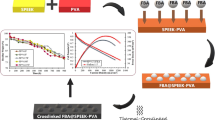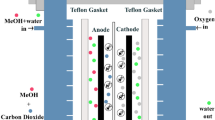Abstract
The paper deals with an alternative energy technology used for the development of perfluorinated polymer membranes for fuel cells. This study has the aim to show some results we obtained using mechanical, rheological, and morphological analyses to get detailed structural information of extruded Nafion and Aquivion membranes suitable for fuel cell applications. Chemical and structural changes before and after annealing have been carefully monitored in order to describe the mechanical and the conductivity properties. The behavior of extruding Nafion and Aquivion membranes was studied and compared with that of the commercial ones. This study illustrates an enhancement of conductivity and mechanical properties for the extruded Nafion and Aquivion membranes.












Similar content being viewed by others
References
Hiesgen R, Wehl I, Aleksandrova E, Roduner E, Bauder A, Friedrich KA (2010) Nanoscale properties of polymer fuel cell materials—a selected review. Int J Energy Res 34:1223–1238
Devanathan R, Venkatnathan A, Rousseau R, Dupuis M, Frigato T, Gu W, Helms V (2010) Atomistic simulation of water percolation and proton hopping in Nafion fuel cell membrane. J Phys Chem B 114(43):13681–13690
Di Noto V, Boaretto N, Negro E, Giffin GA, Lavina S, Polizzi S (2012) Inorganic-organic membranes based on Nafion, [(ZrO2)·(HfO2)0.25] and [(SiO2)·(HfO2)0.28]. Part I: synthesis, thermal stability and performance in a single PEMFC. Int J Hydrog Energy 37:6199–6214
Larminie J, Dicks A (2003) Fuel cell systems explained. Wiley, New York
Srinivasan S (2006) Fuel cells—from fundamentals to applications. Springer, New York
Peighambardoust SJ, Rowshanzamir S, Amjadi M (2010) Review of the proton exchange membranes for fuel cell applications. Int J Hydrog Energy 35:9349–9384
Page KA, Cable KM, Moore RB (2005) Molecular origins of the thermal transitions and dynamic mechanical relaxations in perfluorosulfonate ionomers. Macromolecules 38(15):6472–6484
Aleksandrova E (2012) Visualization of ionically active channels in the Nafion® membrane by using electrochemical atomic force microscopy. Institute fur Physikalishe Cheme der Universtat Stuttgart
Eisenberg A, Yeager HL (eds) (1982) Perfluorinated ionomer membranes, ACS symposium series 180. American Chemical Society, Washington, DC
Schlick S (ed) (1996) Ionomers: characterization, theory and applications. CRC Press, Boca Raton
Gebel G (2000) Structural evolution of water swollen perfluorosulfonated ionomers from dry membrane to solution. Polymer 41:5829–5838
Vogel C, Meier-Haack J (2014) Preparation of ion-exchange materials and membranes. Desalination 342:156–174
Wieser C (2004) Novel polymer electrolytemembranes for automotive applications—requirements and benefits. Fuel Cells 4:245–250
Kreuer KD, Schuster M, Obliers B, Diat O, Traub U, Fuchs A, Klock U, Paddison SJ, Maier J (2008) Short-side-chain proton conducting perfluorosulfonic acid ionomers: why they perform better in PEM fuel cells. J Power Sources 178:499–509
Mohamed HFM, Kobayashi Y, Kuroda CS, Ohira A (2012) Positron trapping and possible presence of SO3H clusters in dry fluorinated polymer electrolyte membranes. Chem Phys Lett 544:49–52
Roche EJ, Pineri M, Duplessix R (1982) Phase separation in perfluorsulfonate ionomer membranes. J Polym Sci 20:107–116
Lin J, Liu Y, Zhang QM (2011) Charge dynamics and bending actuation in Aquivion membrane swelled with ionic liquids. Polymer 52:540–546
Baschetti MG, Minelli M, Catalano J, Sarti GC (2013) Gas permeation in perflurosulfonated membranes: influence of temperature and relative humidity. Int J Hydrog Energy 38:11973–11982
Mauritz KA, Moore RB (2004) State of understanding of Nafion. Chem Rev 104(10):4535–4586
Matos BR, Goulart CA, Santiago E, Muccillo R, Fonseca FC (2014) Proton conductivity of perfluorosulfonate ionomers at high temperature and high relative humidity. Appl Phys Lett 104:091904
Carrot C, Mbarek S, Jaziri M, Chalamet Y, Raveyre C, Prochazka F (2007) Immiscible blends of PC and PET, current knowledge and new results: rheological properties. Macromol Mater Eng 292:693–706
Lehmani A, Durand-Vidal S, Turq P (1998) Surface morphology of Nafion 117 membrane by tapping mode atomic force microscope. J Appl Polym Sci 68(3):503–508
Aleksandrova E, Hiesgen R, Friedrich KA, Roduner E (2007) Electrochemical atomic force microscopy study of proton conductivity in a Nafion membrane. Phys Chem Chem Phys 9:2735–2743
Feng S, Savage J, Voth GA (2012) Effects of polymer morphology on proton solvation and transport in proton-exchange membranes. J Phys Chem C 116(36):19104–19116
Author information
Authors and Affiliations
Corresponding author
Rights and permissions
About this article
Cite this article
Mbarek, S., El Kissi, N., Baccouch, Z. et al. Extrusion of Nafion and Aquivion membranes: environmentally friendly procedure and good conductivities. Polym. Bull. 76, 1151–1166 (2019). https://doi.org/10.1007/s00289-018-2427-6
Received:
Revised:
Accepted:
Published:
Issue Date:
DOI: https://doi.org/10.1007/s00289-018-2427-6




